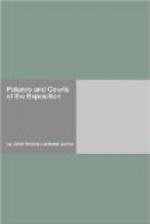The Palace of Manufactures shows the coarser, heavier articles, such as furniture, carpets, woolen goods, hardware. Many articles are being made in this palace.
The Palace of Liberal Arts includes all kinds of printing, book binding, engraving, photographic apparatus, especially in the line of moving pictures and color photography, theatrical appliances, musical instruments, instruments of precision, wireless telegraphy and the wireless telephone, etc.
Palace of Education
Architect — W. B. Faville of San Francisco.
There are three portals on the south in the Spanish Renaissance style, with twisted columns of the Byzantine school. Notice that the screws twist in opposite directions.
Above the central portal is Gustav Gerlach’s tympanum relief “Education.” The tree of knowledge is seen in the background. The kindergarten stage, the half-grown, and the mature periods are shown, the last showing the man no longer under a teacher, but working his problem out by himself.
The modern costumes, combined with the classical styles, suggest that the knowledge of today rests upon that of the old schools. Mr. Gerlach is a pupil of Karl Bitter of New York, the Chief of the Sculpture.
Below the tympanum is the open book of knowledge from which light radiates in all directions. The curtains of darkness have been drawn aside. The hour-glass says, “Improve the shining moments as they pass.”
The crown awaits those who will seek knowledge.
Atop this portal is the globe suggesting that education extends around the world.
The panel on the left shows the female teacher in the center. She is instructing her hearers who discuss their interests.
This panel is by Peters.
The companion panel with the male teacher is by Cesare Stea.
Both panels are quite evident in meaning. Messrs. Peters and Stea are pupils of the Beaux Arts of Paris and the National School of Sculpture of America, respectively.
The Palace of Education and Social Economy shows developments since 1905. Comparative exhibits of educational interests of all nations are shown.
Child welfare, playgrounds, care of the feebleminded, treatment of the insane, missionary work, the Red Cross system, criminology, park systems, street improvements, methods of disposing of sewage, and many other allied subjects are interestingly worked out for public benefit.
The flora is just about the same in front of these palaces as that which you have noticed. The veronica buxifolia is grouped around the lawn at the corner of Palm and Administration Avenues.
The west side of the Palace of Education as well as that of the Palace of Food Products, has great Roman half domes above the entrances. Again your architecture at the portals is changed to suit the style of the palace opposite. The Fine Arts Palace is mainly old Roman.




